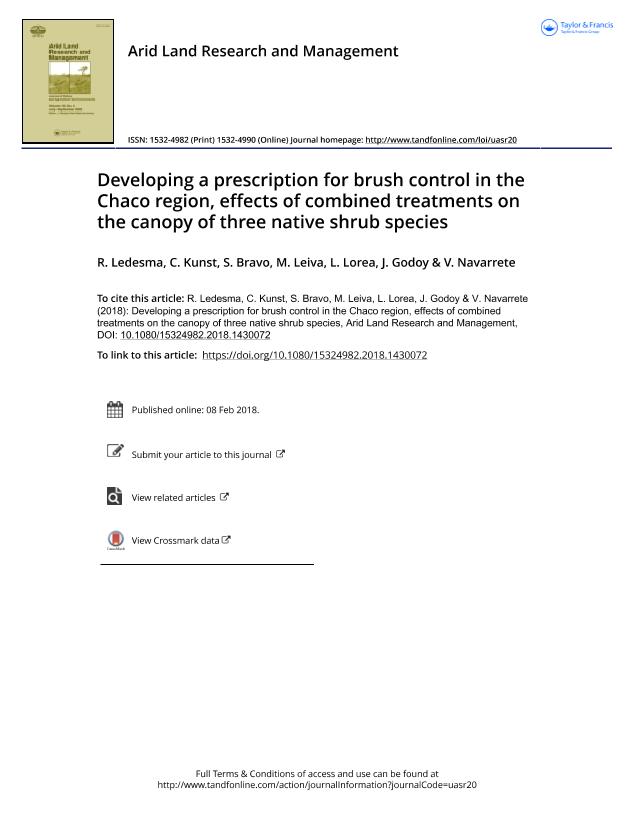Artículo
Developing a prescription for brush control in the Chaco region, effects of combined treatments on the canopy of three native shrub species
Fecha de publicación:
07/2018
Editorial:
Taylor & Francis
Revista:
Arid Land Research And Management
ISSN:
1532-4982
e-ISSN:
1532-4990
Idioma:
Inglés
Tipo de recurso:
Artículo publicado
Clasificación temática:
Resumen
Shrub encroachment is frequent in grazing lands in the Chaco region, Argentina. Fire is used by cattlemen to reduce the dominance of the shrub stands, improve forage standing biomass and quality, and enhance grazing accessibility. In this research, we assessed the combined effect of roller chopping + fire on the plant canopy of three native shrub species, Acacia gilliessi, Celtis ehrenbergiana, and Schinus bumelioides. We used a randomized design, with three factors, year, burn dates, and fine fuel load. Before the burn, the area received a roller-chopping treatment. Canopy volume reduction was assessed using, DifV = −1*(Vi − Va) and DifS = −1*(Si − Sa), respectively, where V = plant volume and S = sprout number. Suffixes i and a represent measurements taken before the roller-chopping treatment and one growth season after the fire, respectively. Fire intensity, headfire residence time, woody residues, and initial plant volume were evaluated as covariates. Results indicate a negative fire effect on canopy volume and sprouting. A. gilliesi was more susceptible to fire than the other two species. High fine fuel load and high fire intensity generated a severe effect on sprout number. The same trend was observed for coarse fuels. The canopy volume reduction was greater in A. gilliesi than the other species, reaffirming its high susceptibility to fire. Head fires were faster in 2009 than in 2008 and in the late than in the early burn dates. These results suggest that mechanical + fire treatments can be useful management tools for controlling shrub encroachment in the western Chaco.
Palabras clave:
FIRE INTENSITY
,
FUEL LOAD
,
ROLLER CHOPPING
,
SPROUTING SHRUBS
Archivos asociados
Licencia
Identificadores
Colecciones
Articulos(SEDE CENTRAL)
Articulos de SEDE CENTRAL
Articulos de SEDE CENTRAL
Citación
Ledesma, R.; Kunst, C.; Bravo, Sandra; Leiva, Marta Elisabeth; Lorea, L.; et al.; Developing a prescription for brush control in the Chaco region, effects of combined treatments on the canopy of three native shrub species; Taylor & Francis; Arid Land Research And Management; 32; 3; 7-2018; 351-366
Compartir
Altmétricas




